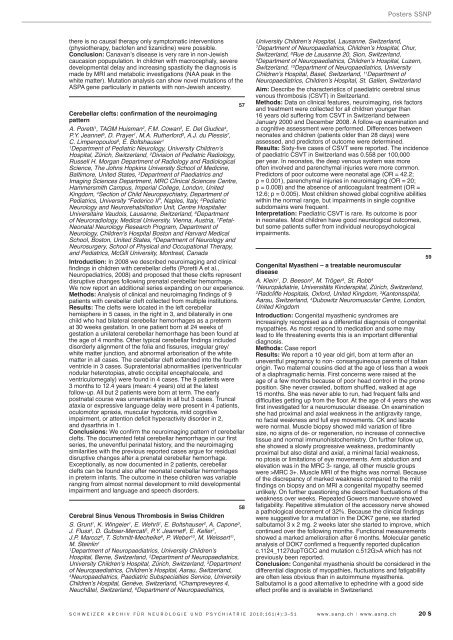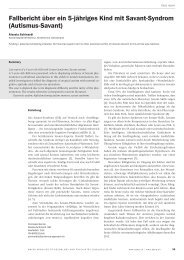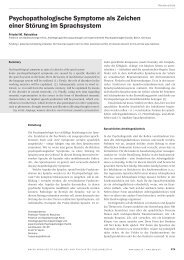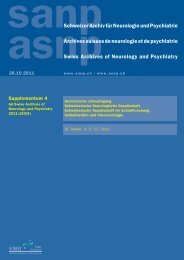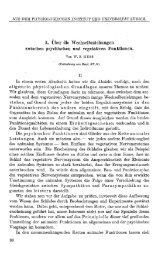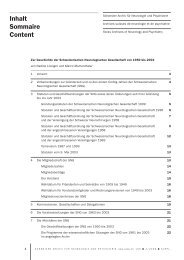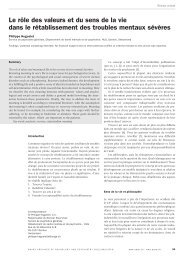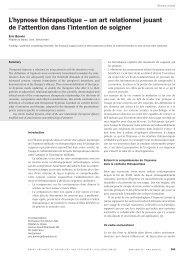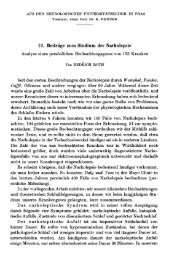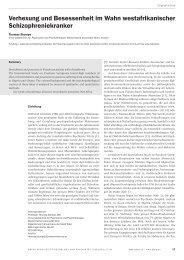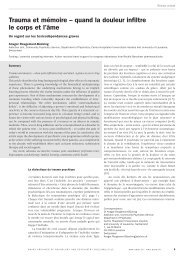Schweizer Archiv für Neurologie und Psychiatrie ... - Sanp.ch
Schweizer Archiv für Neurologie und Psychiatrie ... - Sanp.ch
Schweizer Archiv für Neurologie und Psychiatrie ... - Sanp.ch
You also want an ePaper? Increase the reach of your titles
YUMPU automatically turns print PDFs into web optimized ePapers that Google loves.
Posters SSNP<br />
there is no causal therapy only symptomatic interventions<br />
(physiotherapy, baclofen and tizanidine) were possible.<br />
Conclusion: Canavan’s disease is very rare in non-Jewish<br />
caucasion popupulation. In <strong>ch</strong>ildren with macrocephaly, severe<br />
developmental delay and increasing spasticity the diagnosis is<br />
made by MRI and metabolic investigations (NAA peak in the<br />
white matter). Mutation analysis can show novel mutations of the<br />
ASPA gene particularly in patients with non-Jewish ancestry.<br />
57<br />
Cerebellar clefts: confirmation of the neuroimaging<br />
pattern<br />
A. Poretti 1 , TAGM Huisman 2 , F.M. Cowan 3 , E. Del Giudice 4 ,<br />
P.Y. Jeannet 5 , D. Prayer 1 , M.A. Rutherford 3 , A.J. du Plessis 7 ,<br />
C. Limperopoulos 8 , E. Boltshauser 1<br />
1<br />
Department of Pediatric Neurology, University Children’s<br />
Hospital, Züri<strong>ch</strong>, Switzerland, 2 Division of Pediatric Radiology,<br />
Russell H. Morgan Department of Radiology and Radiological<br />
Science, The Johns Hopkins University S<strong>ch</strong>ool of Medicine,<br />
Baltimore, United States, 3 Department of Paediatrics and<br />
Imaging Sciences Department, MRC Clinical Sciences Centre,<br />
Hammersmith Campus, Imperial College, London, United<br />
Kingdom, 4 Section of Child Neuropsy<strong>ch</strong>iatry, Department of<br />
Pediatrics, University “Federico II”, Naples, Italy, 5 Pediatric<br />
Neurology and Neurorehabilitation Unit, Centre Hospitalier<br />
Universitaire Vaudois, Lausanne, Switzerland, 6 Department<br />
of Neuroradiology, Medical University, Vienna, Austria, 7 Fetal-<br />
Neonatal Neurology Resear<strong>ch</strong> Program, Department of<br />
Neurology, Children’s Hospital Boston and Harvard Medical<br />
S<strong>ch</strong>ool, Boston, United States, 8 Department of Neurology and<br />
Neurosurgery, S<strong>ch</strong>ool of Physical and Occupational Therapy,<br />
and Pediatrics, McGill University, Montreal, Canada<br />
Introduction: In 2008 we described neuroimaging and clinical<br />
findings in <strong>ch</strong>ildren with cerebellar clefts (Poretti A et al.,<br />
Neuropediatrics, 2008) and proposed that these clefts represent<br />
disruptive <strong>ch</strong>anges following prenatal cerebellar hemorrhage.<br />
We now report an additional series expanding on our experience.<br />
Methods: Analysis of clinical and neuroimaging findings of 9<br />
patients with cerebellar cleft collected from multiple institutions.<br />
Results: The clefts were located in the left cerebellar<br />
hemisphere in 5 cases, in the right in 3, and bilaterally in one<br />
<strong>ch</strong>ild who had bilateral cerebellar hemorrhages as a preterm<br />
at 30 weeks gestation. In one patient born at 24 weeks of<br />
gestation a unilateral cerebellar hemorrhage has been fo<strong>und</strong> at<br />
the age of 4 months. Other typical cerebellar findings included<br />
disorderly alignment of the folia and fissures, irregular grey/<br />
white matter junction, and abnormal arborisation of the white<br />
matter in all cases. The cerebellar cleft extended into the fourth<br />
ventricle in 3 cases. Supratentorial abnormalities (periventricular<br />
nodular heterotopias, atretic occipital encephalocele, and<br />
ventriculomegaly) were fo<strong>und</strong> in 4 cases. The 9 patients were<br />
3 months to 12.4 years (mean: 4 years) old at the latest<br />
follow-up. All but 2 patients were born at term. The early<br />
postnatal course was unremarkable in all but 3 cases. Truncal<br />
ataxia or expressive language delay were present in 4 patients,<br />
oculomotor apraxia, muscular hypotonia, mild cognitive<br />
impairment, or attention deficit hyperactivity disorder in 2,<br />
and dysarthria in 1.<br />
Conclusions: We confirm the neuroimaging pattern of cerebellar<br />
clefts. The documented fetal cerebellar hemorrhage in our first<br />
series, the uneventful perinatal history, and the neuroimaging<br />
similarities with the previous reported cases argue for residual<br />
disruptive <strong>ch</strong>anges after a prenatal cerebellar hemorrhage.<br />
Exceptionally, as now documented in 2 patients, cerebellar<br />
clefts can be fo<strong>und</strong> also after neonatal cerebellar hemorrhages<br />
in preterm infants. The outcome in these <strong>ch</strong>ildren was variable<br />
ranging from almost normal development to mild developmental<br />
impairment and language and spee<strong>ch</strong> disorders.<br />
58<br />
Cerebral Sinus Venous Thrombosis in Swiss Children<br />
S. Grunt 1 , K. Wingeier 1 , E. Wehrli 1 , E. Boltshauser 2 , A. Capone 3 ,<br />
J. Fluss 4 , D. Gubser-Mercati 5 , P.Y. Jeannet 6 , E. Keller 7 ,<br />
J.P. Marcoz 8 , T. S<strong>ch</strong>mitt-Me<strong>ch</strong>elke 9 , P. Weber 10 , M. Weissert 11 ,<br />
M. Steinlin 1<br />
1<br />
Department of Neuropaediatrics, University Children’s<br />
Hospital, Berne, Switzerland, 2 Department of Neuropaediatrics,<br />
University Children’s Hospital, Züri<strong>ch</strong>, Switzerland, 3 Department<br />
of Neuropaediatrics, Children’s Hospital, Aarau, Switzerland,<br />
4<br />
Neuropaediatrics, Paediatric Subspecialties Service, University<br />
Children’s Hospital, Genève, Switzerland, 5 Champreveyres 4,<br />
Neu<strong>ch</strong>âtel, Switzerland, 6 Department of Neuropaediatrics,<br />
University Children’s Hospital, Lausanne, Switzerland,<br />
7<br />
Department of Neuropaediatrics, Children’s Hospital, Chur,<br />
Switzerland, 8 Rue de Lausanne 20, Sion, Switzerland,<br />
9<br />
Department of Neuropaediatrics, Children’s Hospital, Luzern,<br />
Switzerland, 10 Department of Neuropaediatrics, University<br />
Children’s Hospital, Basel, Switzerland, 11 Department of<br />
Neuropaediatrics, Children’s Hospital, St. Gallen, Switzerland<br />
Aim: Describe the <strong>ch</strong>aracteristics of paediatric cerebral sinus<br />
venous thrombosis (CSVT) in Switzerland.<br />
Methods: Data on clinical features, neuroimaging, risk factors<br />
and treatment were collected for all <strong>ch</strong>ildren younger than<br />
16 years old suffering from CSVT in Switzerland between<br />
January 2000 and December 2008. A follow-up examination and<br />
a cognitive assessment were performed. Differences between<br />
neonates and <strong>ch</strong>ildren (patients older than 28 days) were<br />
assessed, and predictors of outcome were determined.<br />
Results: Sixty-five cases of CSVT were reported. The incidence<br />
of paediatric CSVT in Switzerland was 0.558 per 100,000<br />
per year. In neonates, the deep venous system was more<br />
often involved and paren<strong>ch</strong>ymal injuries were more common.<br />
Predictors of poor outcome were neonatal age (OR = 42.2;<br />
p = 0.001), paren<strong>ch</strong>ymal injuries in neuroimaging (OR = 20;<br />
p = 0.008) and the absence of anticoagulant treatment (OR =<br />
12.6; p = 0.005). Most <strong>ch</strong>ildren showed global cognitive abilities<br />
within the normal range, but impairments in single cognitive<br />
subdomains were frequent.<br />
Interpretation: Paediatric CSVT is rare. Its outcome is poor<br />
in neonates. Most <strong>ch</strong>ildren have good neurological outcomes,<br />
but some patients suffer from individual neuropsy<strong>ch</strong>ological<br />
impairments.<br />
59<br />
Congenital Myastheni – a treatable neuromuscular<br />
disease<br />
A. Klein 1 , D. Beeson 2 , M. Tröger 3 , St. Robb 4<br />
1<br />
Neuropädiatrie, Universitäts Kinderspital, Züri<strong>ch</strong>, Switzerland,<br />
2<br />
Radcliffe Hospitals, Oxford, United Kingdom, 3 Kantonsspital,<br />
Aarau, Switzerland, 4 Dubowitz Neuromuscular Centre, London,<br />
United Kingdom<br />
Introduction: Congenital myasthenic syndromes are<br />
increasingly recognised as a differential diagnosis of congenital<br />
myopathies. As most respond to medication and some may<br />
lead to life threatening events this is an important differential<br />
diagnosis.<br />
Methods: Case report<br />
Results: We report a 10 year old girl, born at term after an<br />
uneventful pregnancy to non- consanguineous parents of Italian<br />
origin. Two maternal cousins died at the age of less than a week<br />
of a diaphragmatic hernia. First concerns were raised at the<br />
age of a few months because of poor head control in the prone<br />
position. She never crawled, bottom shuffled, walked at age<br />
15 months. She was never able to run, had frequent falls and<br />
difficulties getting up from the floor. At the age of 4 years she was<br />
first investigated for a neuromuscular disease. On examination<br />
she had proximal and axial weakness in the antigravity range,<br />
no facial weakness and full eye movements. CK and lacate<br />
were normal. Muscle biopsy showed mild variation of fibre<br />
size, no signs of de- or regeneration, no increase of connective<br />
tissue and normal immunohisto<strong>ch</strong>emistry. On further follow up,<br />
she showed a slowly progressive weakness, predominantly<br />
proximal but also distal and axial, a minimal facial weakness,<br />
no ptosis or limitations of eye movements. Arm abduction and<br />
elevation was in the MRC 3- range, all other muscle groups<br />
were >MRC 3+. Muscle MRI of the thighs was normal. Because<br />
of the discrepancy of marked weakness compared to the mild<br />
findings on biopsy and on MRI a congenital myopathy seemed<br />
unlikely. On further questioning she described fluctuations of the<br />
weakness over weeks. Repeated Gowers manoeuvre showed<br />
fatigability. Repetitive stimulation of the accessory nerve showed<br />
a pathological decrement of 32%. Because the clinical findings<br />
were suggestive for a mutation in the DOK7 gene, we started<br />
salbutamol 3 x 2 mg. 2 weeks later she started to improve, whi<strong>ch</strong><br />
continued over the following months. Functional measurements<br />
showed a marked amelioration after 6 months. Molecular genetic<br />
analysis of DOK7 confirmed a frequently reported duplication<br />
c.1124_1127dupTGCC and mutation c.512G>A whi<strong>ch</strong> has not<br />
previously been reported.<br />
Conclusion: Congenital myasthenia should be considered in the<br />
differential diagnosis of myopathies, fluctuations and fatigability<br />
are often less obvious than in autoimmune myasthenia.<br />
Salbutamol is a good alternative to ephedrine with a good side<br />
effect profile and is available in Switzerland.<br />
SCHWEIZER ARCHIV FÜR NEUROLOGIE UND PSYCHIATRIE 2010;161(4):3–51 www.sanp.<strong>ch</strong> | www.asnp.<strong>ch</strong> 20 S


